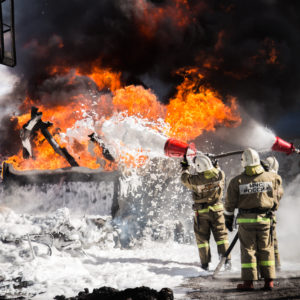Pentagon Undercounting Troops, Families Affected by Toxic PFAS Chemicals on Military Bases, Environmentalists Warn
The Environmental Working Group claims hundreds of thousands of individuals likely affected by toxic PFAS chemicals were not counted in the Defense Department analysis

The Department of Defense (DoD) is likely undercounting the number of service members and families impacted by the toxic effects of water contamination from per- and polyfluoroalkyl substances (PFAS) at or near military bases, according to a recent analysis.
The Environmental Working Group (EWG) released a report last week, which warns that the defense department failed to account for a number of factors in an analysis of military base PFAS water contamination earlier this year, which EWG says results in hundreds of thousands of potential exposures not being counted. In addition, the group says the Department of Defense also downplayed the health risks of PFAS exposure.
Commonly referred to as “forever chemicals”, PFAS were first introduced into the manufacturing industry in the 1940’s, because of their ability to resist heat, grease, stains, and water. However, the chemicals are known to persist in the environment and human body for decades, posing a variety of serious side effects, including liver damage, thyroid disease, decreased fertility, high cholesterol, obesity, hormone suppression, and cancer.
While the chemicals have been widely used in a number of consumer products, most of the military base water contamination problems stem from high levels of the chemicals in aqueous film-forming foam, which has been used by firefighters during training and responses exercises, which usually occur on military bases.
As a result of the poorly regulated and widespread use, PFAS water contamination lawsuits are being filed by plaintiff’s in many areas of the U.S., claiming they developed ulcerative colitis or cancer from high volumes of PFAS chemicals being dumped into the ground water surrounding chemical manufacturing plants and around military bases, airports and other training facilities.
In recent years, hundreds of firefighting foam lawsuits have also been filed by former civilian and military firefighters diagnosed with various forms of cancer after direct exposure to the chemicals, and a number of municipal water systems are also pursuing claims against the chemical manufacturers over clean-up costs.

Learn More About
Exposure to firefighting foam chemicals may result in an increased risk of cancer for firefighters, military and airport personnel.
Learn More About this Lawsuit SEE IF YOU QUALIFY FOR COMPENSATIONIn April, the DoD conducted an assessment of PFAS contamination on U.S. military bases, indicating 24 installations, with a total population of 175,000, exposed residents to PFAS in drinking water. It released the results in June. However, EWG says there are at least 116 such installations, with more than 640,000 likely exposed to PFAS in their drinking water.
The new report claims DoD only looked at PFAS exposure through drinking water and not other means, and also used the U.S. Environmental Protection Agency’s previous PFAS level of concern of 70 parts per trillion (ppt). However, that level was set in 2016, EWG notes. The EPA set new lifetime health advisory levels for PFAS to be less than 1 ppt in June.
Even without the new limits, the EWG report claims that levels of PFAS were higher than 70 ppt on at least four other military bases not mentioned in the DoD analysis, including Fort Leavenworth, Kansas, Picatinny Arsenal in New Jersey, Yakima Training Center in Washington state, and Fort Bragg, North Carolina.
“The DOD’s estimate of service members who were provided contaminated drinking water doesn’t include people who served or lived at those installations in the past. The estimate of 175,000 gives a snapshot of how many people might be drinking contaminated water at any given time,” EWG researchers warn. “The armed services have used firefighting foams containing PFAS at least since the 1970s. But the DOD’s report does not account for the number of service members and their families who lived on bases with contaminated water in the time since then, about 50 years.”
Camp Lejeune Water Contamination Problems
One example of how past exposures are relevant is Camp Lejeune, a U.S. Marine training base in North Carolina, which was plagued by water contamination problems from PFAS and numerous other toxic chemicals which millions of service members, family members and other individuals were exposed to for decades.
Estimates suggest that more than a million Marines and their family members were exposed to contaminated Camp Lejeune water between the early 1950s and late 1980s, with some reports suggesting that toxic chemicals from Camp Lejeune may be responsible for more than 50,000 cases of breast cancer, 28,000 cases of bladder cancer, and 24,000 cases of renal cancer, as well as thousands of cases involve Parkinson’s disease and other health complications. It is also believed that Camp Lejeune water caused birth defects and wrongful death for thousands of unborn children exposed in utero.
For years, Camp Lejeune water injury claims have been denied by the U.S. government, based on qualified immunity defenses and the North Carolina statute of limitations, which was already expired by the time the problems at the Marine base were discovered. However, President Biden and the U.S. Congress have now opened a two year window for veterans, family members and others exposed to the water for at least 30 days between 1953 and 1987 to pursue compensation for their injuries.
The Camp Lejeune Justice Act of 2022 requires that any water contamination lawsuit be brought in the U.S. District Court for the Eastern District of North Carolina by August 10, 2024. However, prior to bringing the lawsuit, the new law requires that the claim be filed with the Office of the Judge Advocate General of the Navy’s Tort Claims Unit (TCU) in Norfolk, Virginia.
During the first month after new landmark legislation went into effect for toxic military exposures, the U.S. government had already received about 5,000 Camp Lejeune water contamination claims submitted by veterans, military family members and others injured by contaminants which impacted the Marine base between 1953 and 1987. However, it is widely expected that hundreds of thousands of cases will ultimately be presented over the next two years by individuals who have been diagnosed with various cancers Parkinson’s disease and other side effects linked to Camp Lejeune water, and is expected to become the largest mass tort litigation in U.S. history.
Get more articles like this sent directly to your inbox.
"*" indicates required fields
1 Comments






MichaelDecember 21, 2022 at 1:42 am
I was in USAF for 22 years working in Aircraft Maintenance at numerous Air Force bases including Pease AFB, NH,Plattsburgh AFB, New York, Luke AFB, AZ, Clark AB, PI , and Dyess AFB, TX. I can seem to get approved for any disability suncei retired in 1996.